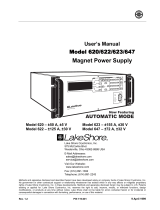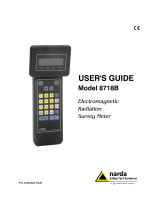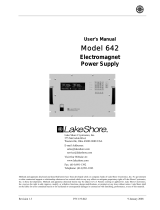Page is loading ...

Model HHG-23
GAUSS / TESLA METER
Instruction Manual
Manual M3685 (UN-01-246)
June 1998
Rev. - 06/98
Omega
All rights reserved.

This symbol appears on the instrument and probe. It
refers the operator to additional information
contained in this instruction manual, also identified
by the same symbol.
NOTICE:
See Pages 3-1 and 3-2
for SAFETY
instructions prior to first use!

i
Table of Contents
SECTION-1 INTRODUCTION
Understanding Flux Density.............................................. 1-1
Measurement of Flux Density............................................
1-2
Product Description........................................................... 1-5
Applications.......................................................................
1-6
SECTION-2 SPECIFICATIONS
Instrument......................................................................... 2-1
Standard Transverse Probe.............................................. 2-5
Standard Axial Probe........................................................ 2-6
Optional Probe Extension Cable....................................... 2-7
Zero Flux Chamber............................................................
2-8
SECTION-3 OPERATING INSTRUCTIONS
Operator Safety.................................................................
3-1
Operating Features........................................................... 3-3
Instrument Preparation......................................................
3-6
Power-Up.......................................................................... 3-8
Power-Up Settings............................................................ 3-9
Low Battery Condition....................................................... 3-10
Overrange Condition......................................................... 3-11
AC or DC Measurement Selection.....................................
3-12
UNITS of Measurement Selection..................................... 3-13
RANGE Selection..............................................................
3-14
HOLD Mode Selection.......................................................
3-16
MIN / MAX Hold Usage......................................................
3-17
Peak Hold Usage.............................................................. 3-18
ZERO Function..................................................................
3-20
Automatic ZERO Function.................................................
3-21
Manual ZERO Function..................................................... 3-23
RELATIVE Mode............................................................... 3-25
Automatic RELATIVE Mode.............................................. 3-28

ii
Manual RELATIVE Mode...................................................
3-30
ANALOG OUTPUT Function............................................. 3-31
Analog Output Usage........................................................
3-33
Sources of Measurement Errors........................................
3-35
More details on AC Mode Operation................................. 3-38
More details on DC Mode Operation................................. 3-40
SECTION-4 REMOTE OPERATION
RS-232 Interface Parameters............................................
4-1
RS-232 Interface Connection............................................ 4-1
Remote Command Standards........................................... 4-3
Command Format..............................................................
4-4
Message Terminators........................................................
4-4
Error Buffer........................................................................
4-5
Status Registers................................................................ 4-5
Status Byte and Request For Service (RQS).................... 4-6
Standard Event Register................................................... 4-9
Measurement Event Register............................................ 4-10
Operation Event Register.................................................. 4-10
Questionable Event Register.............................................
4-11
“Common” Command Syntax............................................ 4-11
“Common” Commands………........................................... 4-13
SCPI Command Syntax.....................................................
4-16
SCPI Commands...............................................................
4-18
Error Messages and Commands....................................... 4-21
Status Commands.............................................................
4-23
MODE Commands............................................................ 4-25
RANGE Commands.......................................................... 4-26
HOLD Commands............................................................. 4-27
ZERO Command...............................................................
4-28
RELATIVE Commands......................................................
4-28
MEASUREMENT Command............................................. 4-29
ANALOG OUTPUT Command.......................................... 4-30
Intermixing Common and SCPI commands.......................
4-31
Using Query Commands................................................... 4-31

iii
Using the Operation Complete Status............................... 4-32
Example Program..............................................................
4-33
WARRANTY....................................................................
5-1
List of Tables
Table 4-1 Common Command Summary.................. 4-13
Table 4-2 SCPI Command Summary........................ 4-18
List of Illustrations
Figure 1-1 Flux Lines of a Permanent Magnet............ 1-1
Figure 1-2 Hall Generator............................................
1-3
Figure 1-3 Hall Probe Configurations.......................... 1-4
Figure 2-1 Standard Transverse Probe.......................
2-5
Figure 2-2 Standard Axial Probe................................. 2-6
Figure 2-3 Optional Probe Extension Cable................
2-7
Figure 2-4 Zero Flux Chamber.................................... 2-8
Figure 3-1 Auxiliary Power Connector Warnings.........
3-1
Figure 3-2 Probe Electrical Warning........................... 3-2
Figure 3-3 Operating Features.................................... 3-3
Figure 3-4 Battery Installation..................................... 3-6
Figure 3-5 Probe Connection...................................... 3-7
Figure 3-6 Power-Up Display...................................... 3-8
Figure 3-7 Missing Probe Indication............................ 3-9
Figure 3-8 Low Battery Indication................................
3-11
Figure 3-9 Overrange Indication ................................ 3-11
Figure 3-10
MODE (AC-DC) Function........................... 3-12
Figure 3-11
UNITS Function..........................................
3-13
Figure 3-12
RANGE Function....................................... 3-15

iv
Figure 3-13
HOLD Function.......................................... 3-17
Figure 3-14
Automatic ZERO Function......................... 3-22
Figure 3-15
Manual ZERO Function..............................
3-24
Figure 3-16
RELATIVE Function...................................
3-28
Figure 3-17
Automatic RELATIVE Function................ 3-29
Figure 3-18
Manual RELATIVE Function...................... 3-31
Figure 3-19
OUTPUT Function......................................
3-32
Figure 3-20
LO and HI Analog Output Displays............ 3-34
Figure 3-21
Adjusting the DC Offset of the Analog
Output........................................................
3-35
Figure 3-22
Probe Output versus Flux Angle................ 3-36
Figure 3-23
Probe Output versus Distance................... 3-37
Figure 3-24
Flux Density Variations in a Magnet...........
3-37
Figure 3-25
Low AC Signal Indication........................... 3-39
Figure 4-1 9-Pin Interface Connector.......................... 4-2
Figure 4-2 Serial Port Connection Schemes............... 4-3
Figure 4-3 Condition, Event and Enable registers.......
4-6
Figure 4-4 Status Byte and Enable registers...............
4-7
Figure 4-5 Standard Event register............................. 4-9
Figure 4-6 Measurement Event register...................... 4-10
Figure 4-7 Operation Event register............................ 4-10
Figure 4-8 Questionable Event register.......................
4-11

1-1
Section 1
Introduction
UNDERSTANDING FLUX DENSITY
Magnetic fields surrounding permanent magnets or electrical
conductors can be visualized as a collection of magnetic flux
lines; lines of force existing in the material that is being subjected
to a magnetizing influence. Unlike light, which travels away from
its source indefinitely, magnetic flux lines must eventually return
to the source. Thus all magnetic sources are said to have two
poles. Flux lines are said to emanate from the “north” pole and
return to the “south” pole, as depicted in Figure 1-1.
Figure 1-1
Flux Lines of a Permanent Magnet
One line of flux in the CGS measurement system is called a
maxwell (M
x
), but the weber (W
b
), which is 10
8
lines, is more
commonly used.
Flux density, also called magnetic induction, is the number of flux
lines passing through a given area. It is commonly assigned the
symbol “B” in scientific documents. In the CGS system a gauss
(G) is one line of flux passing through a 1 cm
2
area. The more

INTRODUCTION
1-2
commonly used term is the tesla (T), which is 10,000 lines per
cm
2
. Thus
1 tesla = 10,000 gauss
1 gauss = 0.0001 tesla
Magnetic field strength is a measure of force produced by an
electric current or a permanent magnet. It is the ability to induce
a magnetic field “B”. It is commonly assigned the symbol “H” in
scientific documents. The unit of “H” in the CGS system is an
oersted (Oe), but the ampere/meter (A/m) is more commonly
used. The relationship is
1 oersted = 79.6 ampere/meter
1 ampere/meter = 0.01256 oersted
It is important to know that magnetic field strength and magnetic
flux density are not the same. The only time the two are
considered equal is in free space (air). Only in free space is the
following relationship true:
1 G = 1 Oe = 0.0001 T = 79.6 A/m
MEASUREMENT OF FLUX DENSITY
A device commonly used to measure flux density is the Hall
generator. A Hall generator is a thin slice of a semiconductor
material to which four leads are attached at the midpoint of each
edge, as shown in Figure 1-2.

INTRODUCTION
1-3
Figure 1-2
Hall Generator
A constant current (Ic) is forced through the material. In a zero
magnetic field there is no voltage difference between the other
two edges. When flux lines pass through the material the path of
the current bends closer to one edge, creating a voltage
difference known as the Hall voltage (Vh). In an ideal Hall
generator there is a linear relationship between the number of
flux lines passing through the material (flux density) and the Hall
voltage.
The Hall voltage is also a function of the direction in which the
flux lines pass through the material, producing a positive voltage
in one direction and a negative voltage in the other. If the same
number of flux lines pass through the material in either direction,
the net result is zero volts. This sensitivity to flux direction makes
it possible to measure both static (dc) and alternating (ac)
magnetic fields.
The Hall voltage is also a function of the angle at which the flux
lines pass through the material. The greatest Hall voltage occurs
when the flux lines pass perpendicularly through the material.
Otherwise the output is related to the cosine of the difference
between 90° and the actual angle.

INTRODUCTION
1-4
The sensitive area of the Hall generator is generally defined as
the largest circular area within the actual slice of the material.
This active area can range in size from 0.2 mm (0.008”) to 19
mm (0.75”) in diameter. Often the Hall generator assembly is too
fragile to use by itself so it is often mounted in a protective tube
and terminated with a flexible cable and a connector. This
assembly, known as a Hall probe, is generally provided in two
configurations:
TRANSVERSE PROBE
AXIAL PROBE
Figure 1-3
Hall Probe Configurations
In “transverse” probes the Hall generator is mounted in a thin, flat
stem whereas in “axial” probes the Hall generator is mounted in a
cylindrical stem. The axis of sensitivity is the primary difference,
as shown by “B” in Figure 1-3. Generally transverse probes are
used to make measurements between two magnetic poles such
as those in audio speakers, electric motors and imaging
machines. Axial probes are often used to measure the magnetic
field along the axis of a coil, solenoid or traveling wave tube.
Either probe can be used where there are few physical space
limitations, such as in geomagnetic or electromagnetic
interference surveys.

INTRODUCTION
1-5
Handle the Hall probe with care. Do not bend the stem or
apply pressure to the probe tip as damage may result. Use
the protective cover when the probe is not in use.
PRODUCT DESCRIPTION
The MODEL HHG-23 GAUSS / TESLAMETER is a portable
instrument that utilizes a Hall probe to measure magnetic flux
density in terms of gauss, tesla or ampere/meter. The
measurement range is from 0.01 mT (0.1 G or 0.01 kA/m) to
2.999T (29.99 kG or 2387 kA/m). The instrument is capable of
measuring static (dc) magnetic fields and alternating (ac) fields.
The MODEL HHG-23 consists of a palm-sized meter and various
detachable Hall probes. The meter operates on standard 9 volt
alkaline batteries or can be operated with an external ac-to-dc
power supply. A retractable bail allows the meter to stand upright
on a flat surface. A notch in the bail allows the meter to be wall
mounted when bench space is at a premium. The large display is
visible at considerable distances. The instrument is easily
configured using a single rotary selector and two pushbuttons.
Three measurement ranges can be selected or the meter can
automatically select the best range based on the present flux
density being measured. A “zero” function allows the user to
remove undesirable readings from nearby magnetic fields
(including earth’s) or false readings caused by initial electrical
offsets in the probe and meter. Included is a “zero flux chamber”
which allows the probe to be shielded from external magnetic
fields during this operation. Another feature called “relative
mode” allows large flux readings to be suppressed so that small
variations within the larger field can be observed directly. Both
the “zero” and “relative” adjustments can be made manually or
automatically.

INTRODUCTION
1-6
Other features include three “hold” modes, allowing either the
arithmetic maximum, minimum or true peak values to be held
indefinitely until reset by the user. An analog signal is available
from a standard BNC connector that is representative of the
magnetic flux density signal and is calibrated to ± 3 volts full scale
in dc mode or 3 Vrms in ac mode. This output can be connected
to a voltmeter, oscilloscope, recorder or external analog-to-digital
converter.
The meter can be fully configured and flux density readings
acquired from a remote computer or PLC using the RS-232
communications port. This is a standard 9-pin “D” connector
commonly used in personal computers. The commands follow
widely accepted protocols established by the IEEE-488.2 and
SCPI-1991 standards.
The meter, probes and accessories are protected when not in
use by a sturdy carrying case.
APPLICATIONS
• Sorting or performing incoming inspection on permanent
magnets, particularly multi-pole magnets.
• Testing audio speaker magnet assemblies, electric motor
armatures and stators, transformer lamination stacks,
cut toroidal cores, coils and solenoids.
• Determining the location of stray fields around medical
diagnostic equipment.
• Determining sources of electromagnetic interference.
• Locating flaws in welded joints.
• Inspection of ferrous materials.
• 3-dimensional field mapping.
• Inspection of magnetic recording heads.

2-1
Section 2
Specifications
INSTRUMENT
RANGE RESOLUTION
gauss tesla A/m gauss tesla A/m
300 G
30 mT
23 kA/m
0.1 G
0.01 mT
0.01 kA/m
3 kG
300 mT
238 kA/m
1 G
0.1 mT
0.1 kA/m
30 kG
3 T
2388 kA/m
10 G
1 mT
1 kA/m
ACCURACY (reading on display and from RS-232 port,
including probe)
dc mode: ± 1 % of reading, ± 3 counts
ac mode:
20 - 10,000 Hz: ± 2.5 % of reading, ± 5 counts
10,000 - 20,000 Hz: ± 5 % of reading, ± 5 counts
ACCURACY (analog output, including probe)
dc mode: ± 1 % of reading, ± 5 mV.
ac mode, low range:
20 - 2000 Hz: ± 3 % of reading, ± 5 mV
10,000 Hz: - 3 dB
ac mode, mid and high range:
20 - 4000 Hz: ± 3 % of reading, ± 5 mV
15,000 Hz: - 3 dB
WARMUP TIME TO RATED
ACCURACY: 15 minutes

SPECIFICATIONS
2-2
MIN / MAX HOLD ACQUISITION TIME:
dc mode: 180 ms typical
ac mode: 300 ms typical
PEAK HOLD ACQUISITION TIME:
dc mode: 1 ms typical
ac mode: 1 ms typical
ANALOG OUTPUT SCALING:
dc mode: ± 3 Vdc
ac mode: 3 Vrms
ANALOG OUTPUT NOISE: 4 mV rms typical
ANALOG OUTPUT LOAD: 10 kΩ min, 100 pF max.
ACCURACY CHANGE WITH
TEMPERATURE
(not including probe): ± 0.02 % / ºC typical
BATTERY TYPE: 9 Vdc alkaline (NEDA 1640A)
BATTERY LIFE: 8 hours typical (two batteries,
analog output and RS-232 port
not used)
AUXILIARY POWER: 6 to 12 Vdc, 300 mA minimum.
AUXILIARY POWER CONNECTOR: Standard 2.5 mm I.D. / 5.5 mm
O.D. connector. Center post is
positive (+) polarity.
ANALOG OUTPUT CONNECTOR: BNC
OPERATING TEMPERATURE: 0 to +50ºC (+32 to +122ºF)

SPECIFICATIONS
2-3
STORAGE TEMPERATURE: -25 to +70ºC (-13 to +158ºF)
METER DIMENSIONS:
Length: 13.2 cm (5.2 in)
Width: 13.5 cm (5.3 in)
Height: 3.8 cm (1.5 in)
WEIGHT:
Meter w/batteries: 400 g (14 oz.)
Shipping: 1.59 kg (3 lb., 8 oz.)
REGULATORY INFORMATION:
Compliance was demonstrated to the following specifications as
listed in the official Journal of the European Communities:
EN 50082-1:1992 Generic Immunity
IEC 801-2:1991 Electrostatic Discharge
Second Edition Immunity
IEC 1000-4-2:1995
ENV 50140:1993 Radiated Electromagnetic
IEC 1000-4-3:1995 Field Immunity
EN 50081-1:1992 Generic Emissions
EN 55011:1991 Radiated and Conducted
Emissions

SPECIFICATIONS
2-4
COMMUNICATIONS PORT:
Format: RS-232C
Lines supported: Transmit, receive, common.
Connector type: 9-pin “D” female
Cable length: 3 m (9.8 ft.) maximum
Receive input resistance: 3 kΩ minimum
Receive voltage limit: ± 30 V maximum
Transmit output voltage: ± 5 V min, ± 8 V typical
Baud rate: 2400
Stop bits: 1
Character length: 8
Parity: None
Standards supported: IEEE-1987.2, SCPI-1991
EMC APPLICATION NOTE
Use only high quality, double shielded cables for RS-232
connection. Keep the length of the cables less than
3 meters (9.8 ft.). Long cables (>3m) with insufficient EMI
shielding can cause excessive emissions or may be
susceptible to external interference.

SPECIFICATIONS
2-5
STANDARD TRANSVERSE PROBE
MODEL NUMBER: STD58-0404
FLUX DENSITY RANGE: 0 to ± 3 T (0 to ± 30 kG)
FREQUENCY BANDWIDTH: 0 - 20 kHz
OFFSET CHANGE WITH
TEMPERATURE: ± 30 µT (300 mG) / ºC typical
ACCURACY CHANGE WITH
TEMPERATURE: - 0.05% / ºC typical
OPERATING TEMPERATURE RANGE: 0 to +75 ºC (+32 to +167ºF)
STORAGE TEMPERATURE RANGE: -25 to +75 ºC (-13 to +167ºF)
Figure 2-1
Standard Transverse Probe

SPECIFICATIONS
2-6
STANDARD AXIAL PROBE
MODEL NUMBER: SAD58-1904
FLUX DENSITY RANGE: 0 to ± 3 T (0 to ± 30 kG)
FREQUENCY BANDWIDTH: 0 - 20 kHz
OFFSET CHANGE WITH
TEMPERATURE: ± 30 µT (300 mG) / ºC typical
ACCURACY CHANGE WITH
TEMPERATURE: - 0.05% / ºC typical
OPERATING TEMPERATURE RANGE: 0 to +75 ºC (+32 to +167ºF)
STORAGE TEMPERATURE RANGE: -25 to +75 ºC (-13 to +167ºF)
Figure 2-2
Standard Axial Probe

SPECIFICATIONS
2-7
OPTIONAL PROBE EXTENSION CABLE
MODEL NUMBER: X5000-0006
OPERATING TEMPERATURE RANGE: 0 to +75 ºC (+32 to +167ºF)
STORAGE TEMPERATURE RANGE: -25 to +75 ºC (-13 to +167ºF)
Figure 2-3
Optional Probe Extension Cable

SPECIFICATIONS
2-8
ZERO FLUX CHAMBER
MODEL NUMBER: YA-111
CAVITY DIMENSIONS:
Length: 50.8 mm (2”)
Diameter: 8.7 mm (0.343”)
ATTENUATION: 80 dB to 30 mT (300 G)
PURPOSE: To shield the probe from
external magnetic fields during
the ZERO or RELATIVE
operations.
Figure 2-4
Zero Flux Chamber
/





